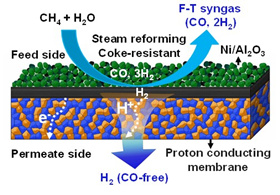

In recent years, hydrogen energy has received more and more attention and attention. Hydrogen can be produced by natural gas reforming, but the obtained hydrogen contains CO, which can easily cause poisoning of fuel cell electrocatalysts. The cumbersome CO removal process has become an essential part of the hydrogen production technology, significantly increasing equipment investment and operating costs. How to produce CO-free clean hydrogen stably, efficiently and at low cost has become an important research direction of hydrogen energy development.
Jiang Heqing, a researcher at the Qingdao Institute of Bioenergy and Processes, Chinese Academy of Sciences, and German collaborators used a ceramic oxygen-permeable membrane reactor to couple water decomposition and alkane oxidation reactions on both sides of the oxygen-permeable membrane to promote water decomposition and hydrogen production (Angew. Chem . Int. Ed. 2008, 47, 9341; Angew. Chem. Int. Ed. 2010, 49, 5656). Recently, the Membrane Separation and Catalysis Research Group proposed to perform methane steam reforming reaction in a dense ceramic hydrogen permeable membrane reactor to separate hydrogen in situ. Unlike common polymer membranes and molecular sieve membranes, the separation selectivity of dense ceramic hydrogen permeable membranes for hydrogen reaches 100%, and completely CO-free hydrogen is obtained on the other side of the membrane. This work uses a ceramic hydrogen permeable membrane to couple the natural gas reforming reaction and the hydrogen separation process to obtain the synthesis gas and CO-free hydrogen required for Fischer-Tropsch synthesis in one step, which simplifies the hydrogen production process and provides efficient and low-cost preparation of clean hydrogen Provides a new way of thinking. Related results were recently published in the AIChE Journal, an international journal in the field of chemical engineering (AIChE J 2019, 65, DOI: 10.1002 / aic.16740).
The key to hydrogen production technology based on ceramic oxygen permeable membranes or hydrogen permeable membranes is to improve the stability and permeability of membrane materials. In order to solve the problem of the attenuation of the permeation membrane Ba0.5Sr0.5Co0.8Fe0.2O3-δ commonly used in low temperature at low and medium temperature, the research team recently cooperated with the scientific researchers of the Ulysse Research Center in Germany, through the W element doping , After high temperature sintering, self-assembled to form a composite film with single perovskite and double perovskite coexisting, with the help of Fe and W to thermally induce mutual diffusion between the two phases, in-situ adjustment of the two-phase chemical composition in the composite film, to stabilize the structure of the titanium ore And inhibit its degradation, significantly improve the stability of the oxygen-permeable membrane. Related results were recently published on Chem Mater (Chem Mater, 2019, 31, 7487-7492).
In addition, the common cobalt- and iron-containing oxygen-permeable membrane materials are prone to be deeply reduced under hydrogen production conditions and cause membrane material degradation (ACS Sustainable Chem. Eng. 2017, 5, 8657; Int J Hydrogen Energy, 2018, 42 , 14478), the research team and German collaborators tried for the first time to use a new generation of titanate-based ceramic membrane material SrMg0.15Zr0.05Ti0.8O3-δ which contains neither Co nor Fe, and mainly Ti. The structure remained unchanged after 100 hours of exposure to 20 vol.% H2 atmosphere, showing excellent chemical stability. This type of Ti-based oxygen permeable membrane is used in the coupling process of water splitting to produce hydrogen and methane reforming reaction, which achieves continuous and stable operation in the laboratory, and the hydrogen yield reaches 0.7 m3 h-1 m-2. This achievement is expected to solve the problem of poor stability of traditional ceramic membrane materials under hydrogen production conditions, and promote the development of ceramic membrane hydrogen production technology. Related achievements were recently published in the iScience magazine, a sub-journal of Cell (iScience, 2019, 19, 955-964).
The above work was supported by the National Natural Science Foundation of China and the International Cooperation Project of the Chinese Academy of Sciences.
ZHejiang Sealand Technology Co., Ltd. is a trustworthy manufacturer of LNG Mass Flow Meter, LNG Mass Flowmeter, LNG Flow Meter, LNG Flowmeter, LNG meter, ATEX, IECEx & CE approved.
We are the only Chinese brand who gets ATEX, and we get it from TUV SUD, the most authoritative institute for ATEX. Our meter passed all tests carried out by TUV without any modification. Their only suggestion is to replace the cable entry device with a ATEX approved one; thus, please rest assured that we produce our meter with high standard :)
Besides, Sealand meter and calibration lab are approved by CNAS, member of ilac in China.
The 1'' flow meter specification is as follows,
|
Specifications of Coriolis Mass Flow Meter |
|
|
Model No. |
CG-25 |
|
Max. flow rate |
200kg/min |
|
Nominal diameter |
25mm( 1 inch) |
|
LNG accuracy grade |
±0.2% |
|
Zero stability |
0.62kg/hr |
|
Repeatability |
0.05% |
|
Warranty |
2 years |
|
Temperature accuracy |
±1°C ±0.5% of reading |
|
Fluid temperature |
-200~160°C |
|
Packing |
1set/carton |
|
Package size |
665*660*315mm |
|
G.W. |
23kgs |
Please feel free to contact us if you need any other size!
LNG Mass Flow Meter, LNG Mass Flowmeter, LNG Flow Meter, LNG Flowmeter, LNG meter
Zhejiang Sealand Technology Co., Ltd. , https://www.sealandflowmeter.com
